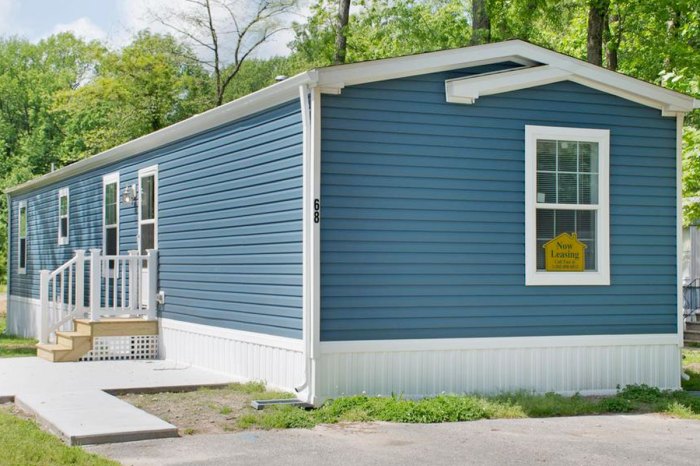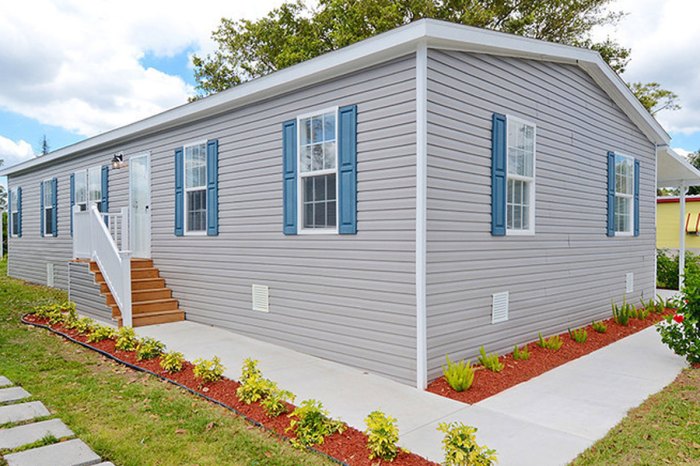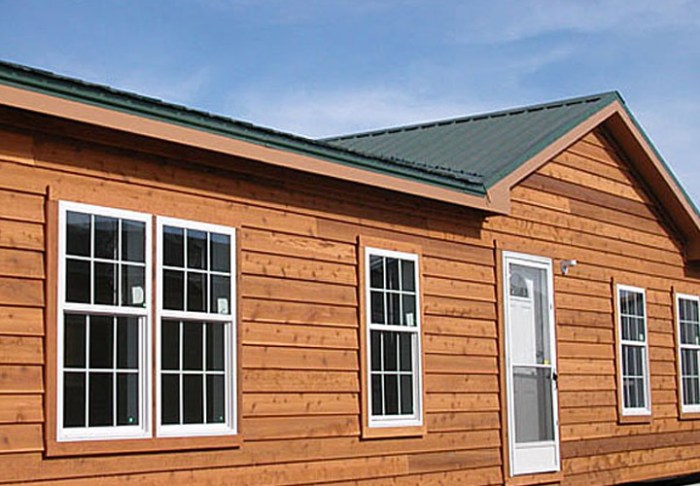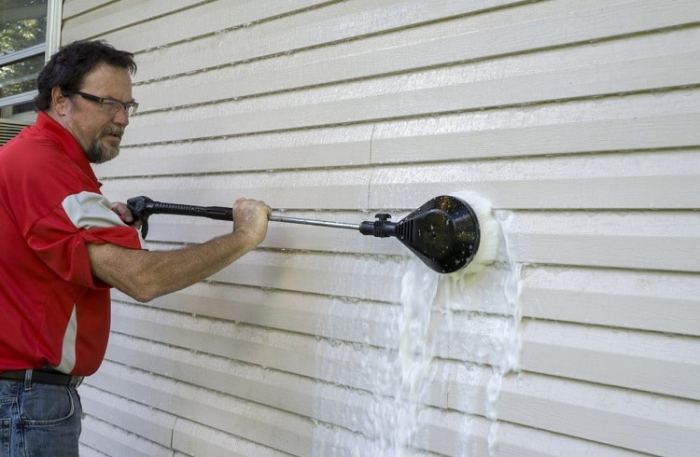Manufactured home siding: the unsung hero of curb appeal and property value. Choosing the right siding isn’t just about aesthetics; it’s a crucial decision impacting durability, maintenance, and even your home’s resale value. This comprehensive guide dives deep into the world of manufactured home siding, exploring various materials, installation techniques, maintenance best practices, and design considerations to help you make an informed choice that perfectly complements your home and budget.
From understanding the differences between vinyl, aluminum, fiber cement, and wood siding to mastering installation techniques and addressing common problems, we’ll equip you with the knowledge to transform your manufactured home’s exterior. We’ll also explore the environmental impact of different siding options, helping you choose sustainably while maximizing your home’s energy efficiency and long-term value. Get ready to unlock the full potential of your manufactured home’s exterior.
Types of Manufactured Home Siding
Choosing the right siding for your manufactured home is a crucial decision impacting aesthetics, durability, and long-term maintenance. The selection process involves considering various factors, including budget, desired aesthetic, and the local climate. Several materials offer distinct advantages and disadvantages, making careful consideration essential.
Manufactured Home Siding Materials
Manufactured homes utilize a variety of siding materials, each possessing unique properties. Common options include vinyl, aluminum, fiber cement, and wood, each offering a distinct balance of cost, durability, and aesthetic appeal. Less common, but still available, options include steel and engineered wood.
Durability Comparison of Common Siding Materials
Vinyl siding is known for its affordability and low maintenance. It’s resistant to moisture and insect damage, but can be susceptible to cracking or fading under extreme temperature fluctuations or prolonged sun exposure. Aluminum siding, while durable and resistant to dents and scratches, can dent easily upon impact and may be susceptible to corrosion in harsh coastal environments. Fiber cement siding offers superior durability and fire resistance, resisting moisture, insects, and extreme weather conditions, though it’s heavier and more challenging to install than vinyl. Wood siding, while aesthetically pleasing, requires significant maintenance to prevent rot, insect infestation, and weathering, and its lifespan is considerably shorter than fiber cement or even vinyl, depending on the type of wood and the climate.
Aesthetic Considerations for Manufactured Home Siding
The aesthetic appeal of siding significantly impacts the overall look of a manufactured home. Vinyl siding offers a wide array of colors and textures, mimicking the appearance of wood, brick, or stone. Aluminum siding is typically available in a range of colors, but its smooth, metallic finish is distinct. Fiber cement siding can be textured to resemble wood shakes or shingles, offering a more natural look, while allowing for a wide variety of colors. Wood siding offers unparalleled natural beauty, with variations in grain and color providing unique character, although this requires regular maintenance to retain its appeal.
Cost, Maintenance, and Lifespan of Manufactured Home Siding
The following table summarizes the cost, maintenance requirements, and typical lifespan of common manufactured home siding materials. These values are estimates and can vary based on factors such as material quality, installation costs, and regional pricing.
| Material | Cost | Maintenance | Lifespan (Years) |
|---|---|---|---|
| Vinyl | Low to Moderate | Low | 20-30 |
| Aluminum | Moderate | Low to Moderate | 30-50 |
| Fiber Cement | Moderate to High | Low | 50+ |
| Wood | Moderate to High | High | 15-25 |
Installation and Maintenance of Manufactured Home Siding
Proper installation and consistent maintenance are crucial for extending the lifespan and preserving the aesthetic appeal of your manufactured home’s siding. Neglecting either can lead to premature deterioration, costly repairs, and even structural damage. This section details the process of vinyl siding installation and provides guidance on maintaining various siding types.
Vinyl Siding Installation on a Manufactured Home
Installing vinyl siding on a manufactured home requires careful preparation and precise execution. The process typically involves several key steps. First, the existing siding must be removed, ensuring the underlying sheathing is sound and free from rot or damage. Any necessary repairs to the sheathing should be completed before proceeding. Next, a water-resistant barrier, such as house wrap, is applied to protect the home from moisture. This step is critical for preventing water damage and mold growth. Following this, the installation of starter strips at the bottom of the wall establishes a level and straight baseline for the rest of the siding. Vinyl siding panels are then installed, overlapping each course and securing them with nails or clips, paying close attention to proper alignment and spacing. J-channels and other trim pieces are installed around windows, doors, and corners to create a neat and finished look. Finally, all seams and fasteners should be inspected to ensure a watertight seal.
Maintaining Different Types of Manufactured Home Siding
Different siding materials require specific maintenance routines. Vinyl siding is relatively low-maintenance, typically requiring only occasional cleaning with soap and water to remove dirt and grime. Avoid using abrasive cleaners or power washers, which can damage the surface. Aluminum siding, while durable, can be susceptible to scratches and dents. Regular inspection for damage and prompt repair are important. Wood siding demands more attention. It should be regularly inspected for signs of rot, insect infestation, or damage. Periodic repainting or staining is necessary to protect the wood from the elements and maintain its appearance. Fiber cement siding is generally very durable and low-maintenance, but it may require occasional cleaning and sealing to prevent water damage.
Common Problems During Manufactured Home Siding Installation and Their Solutions
Several issues can arise during manufactured home siding installation. Improper flashing around windows and doors can lead to water leaks. Solutions include ensuring proper flashing installation and using sealant to create a watertight seal. Uneven sheathing can result in gaps and inconsistencies in the siding. Addressing sheathing irregularities before siding installation is crucial. Using the wrong type of nails or fasteners can cause damage to the siding. Using nails specifically designed for vinyl siding is essential. Insufficient overlap between siding panels can create gaps, leading to water penetration. Careful attention to overlapping panels is vital for a weathertight installation.
Manufactured Home Siding Inspection and Maintenance Checklist
Regular inspection and maintenance are vital for preventing costly repairs and extending the lifespan of your siding. A comprehensive checklist should include:
- Visual inspection of all siding panels for cracks, damage, or discoloration.
- Checking for gaps or openings around windows, doors, and other openings.
- Examining the caulking and sealant around trim pieces for deterioration.
- Inspecting the flashing around windows and doors for proper installation and condition.
- Cleaning the siding with a mild soap and water solution, avoiding harsh chemicals or pressure washers.
- For wood siding, inspecting for signs of rot, insect infestation, or damage, and addressing these issues promptly.
- For painted siding, assessing the condition of the paint and repainting as needed.
Regular adherence to this checklist can significantly prolong the life of your manufactured home’s siding and maintain its aesthetic appeal.
Siding and Home Value: Manufactured Home Siding

Upgrading your manufactured home’s siding can significantly impact its overall value and curb appeal. The right siding choice not only enhances aesthetics but also contributes to the home’s perceived condition and longevity, influencing potential buyers’ perceptions and ultimately, the sale price. Different siding materials offer varying degrees of return on investment (ROI), making informed decisions crucial for maximizing property value.
The choice of siding material directly affects a manufactured home’s perceived value. Higher-end materials like vinyl, fiber cement, or even metal siding, when properly installed, can significantly increase a home’s market value compared to older, damaged, or less attractive siding options. This is because these materials offer superior durability, weather resistance, and aesthetic appeal, leading to a higher perceived quality and value. Conversely, outdated or poorly maintained siding can detract significantly from the home’s overall value, making it harder to sell and potentially lowering the asking price.
Return on Investment for Siding Upgrades, Manufactured home siding
The return on investment for a manufactured home siding upgrade varies depending on several factors, including the initial cost of materials and labor, the chosen material, the home’s location, and the overall condition of the property. While precise figures are difficult to provide without specific circumstances, a general guideline suggests that a well-executed siding upgrade can recoup a substantial portion of the investment upon resale. For instance, replacing outdated aluminum siding with modern vinyl siding in a desirable neighborhood might yield a return of 70-80% of the upgrade cost, increasing the home’s saleability and fetching a higher offer. Conversely, investing in a luxury material like fiber cement in a less competitive market may have a slower ROI. A thorough cost-benefit analysis is recommended before embarking on any siding project.
Siding’s Contribution to Curb Appeal and Property Value
Curb appeal, the visual attractiveness of a property from the street, plays a pivotal role in determining its market value. Siding is a major contributor to curb appeal; attractive, well-maintained siding instantly improves a home’s appearance, making it more inviting and appealing to potential buyers. This improved visual impression translates directly into a higher perceived value and a greater likelihood of a quicker and more profitable sale. A home with fresh, modern siding stands out from comparable properties with older, damaged siding, potentially commanding a higher sale price. Conversely, neglected or damaged siding can significantly reduce curb appeal, making the home appear less desirable and impacting its market value negatively. Imagine two identical manufactured homes; one with updated, vibrant siding and the other with faded, peeling siding. The former will undoubtedly command a higher price.
Factors Influencing the Value Impact of Manufactured Home Siding
The impact of siding on a manufactured home’s value isn’t solely determined by the material itself. Several interconnected factors contribute to the overall effect.
- Material Choice: Higher-quality, durable materials like fiber cement or engineered wood offer a greater return on investment than cheaper alternatives that require more frequent maintenance and replacement.
- Installation Quality: Professional, meticulous installation is crucial. Poorly installed siding can lead to premature damage, reducing the perceived value and potentially leading to costly repairs.
- Color and Style: Choosing siding colors and styles that complement the home’s architecture and the neighborhood’s aesthetic can enhance curb appeal and increase value. Conversely, clashing or outdated choices can have a negative impact.
- Overall Home Condition: Siding upgrades are most effective when the rest of the home is well-maintained. A new siding job on a dilapidated home might not yield the same ROI as the same upgrade on a well-maintained property.
- Neighborhood and Market Conditions: The local real estate market and the condition of neighboring properties significantly influence the return on investment. A high-end siding upgrade in a lower-value neighborhood may not yield the same return as in a more affluent area.
Environmental Considerations

Choosing siding for a manufactured home involves more than just aesthetics and cost; it significantly impacts the environment. The manufacturing process, material lifespan, and eventual disposal all contribute to a material’s overall environmental footprint. Understanding these factors allows for informed decisions that minimize environmental impact.
Different siding materials have varying environmental consequences. The production of vinyl siding, for example, is energy-intensive and relies on non-renewable resources like petroleum. Furthermore, vinyl siding is not easily recyclable and often ends up in landfills, contributing to plastic waste. Conversely, materials like fiber cement and certain types of wood siding, while potentially requiring more energy in their initial manufacturing, can be more durable and have longer lifespans, reducing the overall need for replacement and waste generation over time. Aluminum siding, while recyclable, has a high embodied energy due to the extensive energy required for aluminum production.
Sustainable and Eco-Friendly Siding Options
Sustainable siding options for manufactured homes prioritize reduced environmental impact throughout their lifecycle. This includes minimizing energy consumption during manufacturing, utilizing recycled or renewable materials, and ensuring ease of recycling or responsible disposal. Examples include siding made from recycled materials, such as reclaimed wood or plastic, or siding manufactured using renewable energy sources. Plant-based materials like bamboo, while not as common in manufactured home siding, represent a potentially more sustainable option compared to petroleum-based products. The use of sustainably harvested wood, certified by organizations like the Forest Stewardship Council (FSC), further minimizes the environmental impact associated with wood siding. It’s crucial to verify certifications and sourcing practices to ensure true sustainability.
Energy Efficiency and Insulation
The energy efficiency of manufactured home siding is intrinsically linked to its impact on overall home insulation. Siding materials with high thermal resistance values (R-values) help to reduce heat transfer, minimizing energy consumption for heating and cooling. For example, fiber cement siding often provides better insulation than vinyl, potentially leading to lower energy bills and a smaller carbon footprint. Proper installation of any siding material, ensuring a tight seal and minimizing air leaks, is also critical to maximizing energy efficiency. This is particularly important for manufactured homes, which are often more susceptible to air infiltration than traditional stick-built homes. The combined impact of high-performance siding and effective insulation can significantly reduce a manufactured home’s energy needs.
Recycling and Responsible Disposal Methods
Recycling and responsible disposal practices are crucial for minimizing the environmental impact of manufactured home siding. While vinyl siding is notoriously difficult to recycle, some regions have programs that accept it for energy recovery. Aluminum siding is generally recyclable and can be collected through scrap metal recycling programs. Wood siding, depending on its condition and treatment, may be suitable for reuse or recycling in some cases. Fiber cement siding, while not readily recyclable in the same way as aluminum, has a lower environmental impact due to its longer lifespan and durability. Always check with local waste management facilities for proper disposal guidelines and recycling options specific to your area and siding material. Landfill disposal should be considered a last resort, and exploring options like material reuse or recycling programs should always be prioritized.
Design and Aesthetics

Manufactured home siding offers a surprisingly wide array of design possibilities, significantly impacting the overall curb appeal and perceived value of the home. Careful selection of siding color, style, pattern, and texture can transform a manufactured home from ordinary to extraordinary, reflecting the homeowner’s personal style and enhancing the property’s aesthetic appeal. The right siding choices can even subtly alter the perceived size and shape of the home, creating a more visually balanced and harmonious design.
The interplay between siding and architectural design is crucial. Different siding materials and finishes complement various architectural styles, from traditional to contemporary. Lighter colors can make a home appear larger and brighter, while darker shades can create a more dramatic and sophisticated look. Texture and pattern choices further contribute to this visual effect, adding depth and dimension to the home’s exterior.
Siding Color and Style Choices for Different Architectural Designs
Choosing siding that complements the architectural style of your manufactured home is key to achieving a cohesive and aesthetically pleasing design. For instance, a traditional ranch-style home might be beautifully enhanced with horizontal lap siding in a warm, earthy tone like beige or brown. These colors evoke a sense of comfort and familiarity, aligning perfectly with the traditional style. In contrast, a more modern, contemporary manufactured home might benefit from sleek vertical siding in a bold color such as gray or charcoal, reflecting the clean lines and minimalist aesthetic of modern architecture. A craftsman-style home, with its intricate detailing, might be best complemented by a textured siding, such as cedar shake or stone veneer, that enhances the home’s natural, rustic charm.
Examples of Manufactured Home Siding Designs that Enhance Curb Appeal
The right siding choices can dramatically increase a manufactured home’s curb appeal. Consider these examples:
- Classic Elegance: Imagine a single-wide manufactured home clad in creamy white vinyl siding with dark brown trim. The simple, elegant design is further enhanced by the addition of strategically placed window boxes filled with vibrant flowers. This creates a welcoming and visually appealing entrance, enhancing the overall charm of the home.
- Modern Minimalism: A double-wide manufactured home with sleek, dark gray fiber cement siding paired with large, energy-efficient windows creates a modern, minimalist aesthetic. The clean lines of the siding are complemented by a minimalist landscaping design, emphasizing the home’s contemporary style and enhancing its visual appeal.
- Rustic Charm: A manufactured home featuring natural wood siding (or a high-quality wood-look vinyl alternative) in a warm, honey-brown tone exudes rustic charm. This style is enhanced by the addition of a stone veneer base and a covered porch with exposed wooden beams. This combination creates a cozy and inviting atmosphere, maximizing the home’s visual appeal.
The Effect of Siding Patterns and Textures on Visual Appeal
Siding patterns and textures add significant depth and visual interest to a manufactured home’s exterior. Horizontal lap siding, a classic choice, creates a sense of width and stability. Vertical siding, on the other hand, can make a home appear taller and more slender. Textured siding, such as wood shakes or stone veneer, adds visual complexity and can subtly alter the perceived size and scale of the home. The interplay of light and shadow on textured surfaces creates a dynamic and engaging facade. For example, a home with rough-hewn wood siding will project a different feeling than one with smooth, painted vinyl siding. The choice of texture should complement the overall architectural style and the homeowner’s aesthetic preferences.
Using Siding to Create Visual Interest and Architectural Details
Siding can be strategically used to create visual interest and architectural details, even on a manufactured home. This can be achieved through the use of contrasting colors, patterns, and textures. For example, using a darker color siding on the lower portion of the home and a lighter color on the upper portion can create a visual separation and add depth. Accenting certain architectural features, such as window frames or dormers, with a contrasting color or material can draw the eye and highlight these details. Similarly, using different siding materials in strategic locations can add visual interest and create a more customized look. Careful planning and execution can significantly enhance the overall aesthetic appeal of a manufactured home.
Repair and Replacement of Manufactured Home Siding
Manufactured home siding, while durable, is susceptible to damage from various sources. Understanding the causes of damage and employing appropriate repair or replacement techniques is crucial for maintaining the home’s aesthetic appeal and structural integrity. Ignoring damage can lead to more extensive and costly repairs in the future, potentially affecting the home’s value. This section details common damage causes, repair methods for minor issues, the process of replacing damaged sections, and when replacement is more economical than repair.
Common Causes of Manufactured Home Siding Damage
Several factors contribute to damage in manufactured home siding. Weather is a primary culprit; harsh sunlight can cause fading and cracking, while extreme temperature fluctuations lead to expansion and contraction, potentially weakening the siding and causing warping or buckling. High winds can dislodge or damage siding, especially if poorly installed or maintained. Impact damage from flying debris, such as branches or hail, is another common issue. Finally, pests like carpenter ants can cause significant damage by burrowing into the siding and weakening its structure. Regular inspections are key to identifying problems early.
Repairing Minor Damage to Vinyl Siding
Minor damage, such as small cracks or holes, can often be repaired effectively. This is usually a cost-effective alternative to full replacement. The specific repair method depends on the type and extent of the damage. For example, small cracks in vinyl siding can often be repaired with vinyl caulk designed for exterior use. This caulk should be applied neatly and allowed to dry completely before painting to match the existing siding color. For small holes, a vinyl patch kit can be used. These kits typically include a patch material that matches the siding color and adhesive to secure it in place. The patch should be carefully trimmed to fit the hole and pressed firmly against the siding to ensure a good seal. After the adhesive dries, the area can be painted to blend seamlessly with the surrounding siding.
Replacing Damaged Sections of Manufactured Home Siding
More extensive damage, such as large cracks, significant warping, or severe impact damage, often requires replacing the affected siding section. This process generally involves removing the damaged panel(s) and installing new ones. Before starting, it’s crucial to carefully assess the extent of the damage to determine how many panels need replacing. The replacement panels should be the same type and color as the existing siding to maintain a consistent look. Removing the damaged panels typically involves carefully prying them away from the underlying structure using a putty knife or similar tool. The new panels are then installed using appropriate fasteners, ensuring they are securely attached and aligned correctly. Finally, caulking around the edges of the new panels helps seal them against moisture and prevent future damage. This requires careful attention to detail to ensure a watertight seal and a professional finish.
Repair Versus Replacement Cost-Effectiveness
The decision to repair or replace damaged siding depends on several factors, including the extent of the damage, the cost of materials and labor, and the homeowner’s budget. Minor damage, such as small cracks or holes, is generally more cost-effective to repair. For example, repairing a small crack with vinyl caulk might cost only a few dollars and take an hour or less, while replacing an entire panel could cost tens of dollars in materials and several hours of labor. However, extensive damage, such as significant warping or multiple damaged panels, often makes replacement more economically viable in the long run. For instance, repairing numerous small holes might cost more than simply replacing a single panel. It’s advisable to obtain quotes from reputable contractors for both repair and replacement options to make an informed decision. Consider the long-term implications of a repair that might compromise the integrity of the siding and necessitate replacement sooner rather than later.
Ultimately, selecting the right manufactured home siding involves careful consideration of numerous factors. From the initial cost and long-term maintenance to the aesthetic appeal and environmental impact, each decision plays a vital role in shaping your home’s character and value. By understanding the nuances of different materials, installation processes, and design possibilities, you can confidently choose a siding solution that enhances your home’s beauty, durability, and overall value for years to come. Remember to prioritize regular maintenance to protect your investment and prolong the lifespan of your siding.
FAQ Resource
Can I install manufactured home siding myself?
While DIY installation is possible for some siding types, particularly vinyl, it’s often recommended to hire a professional for a flawless finish and to avoid potential warranty issues. Improper installation can lead to damage and costly repairs.
How often should I clean my manufactured home siding?
Regular cleaning, ideally twice a year (spring and fall), helps prevent dirt buildup and prolongs the life of your siding. Use a gentle detergent and water solution, avoiding harsh chemicals that could damage the surface.
What are the signs I need to replace my siding?
Significant damage like cracks, holes, or warping indicates the need for replacement. Persistent water damage or severe discoloration are also warning signs. Consider replacement if repairs become too extensive or costly.
Does manufactured home siding affect my home insurance?
Upgrading to more durable and fire-resistant siding may positively impact your home insurance premiums, potentially lowering your rates. Contact your insurance provider for specific details.
What is the average lifespan of different manufactured home siding materials?
Lifespans vary greatly. Vinyl typically lasts 20-30 years, aluminum 40-50 years, fiber cement 50+ years, and wood can last for decades with proper maintenance, though it requires more upkeep.



